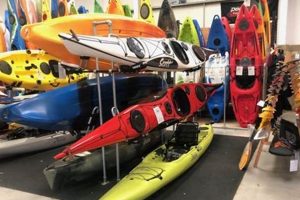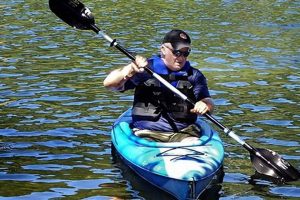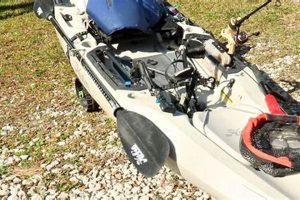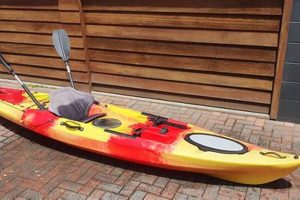Longer, wider, and more stable watercraft designed for enhanced capacity and stability are often preferred by larger paddlers, those seeking to carry additional gear, or individuals prioritizing a comfortable and secure paddling experience. These craft offer ample storage for equipment like camping gear, fishing tackle, or photographic equipment, making them suitable for extended trips and specialized activities.
The increased stability and load-bearing capacity of these larger vessels provide a significant advantage in various conditions. They are less susceptible to tipping, particularly beneficial for novices or those paddling in challenging waters. Historically, larger canoes and kayaks have played crucial roles in exploration, trade, and transportation, highlighting their enduring utility. Their contemporary adaptations continue to serve diverse recreational and professional purposes.
This discussion will further explore key considerations for selecting an appropriate watercraft size, including factors such as paddler size and weight, intended use, and water conditions. Subsequent sections will delve into specific design features, materials, and popular models, offering readers a comprehensive guide to informed decision-making.
Tips for Selecting Larger Kayaks
Choosing a larger kayak requires careful consideration of several factors to ensure optimal performance, safety, and enjoyment on the water. The following tips provide guidance for navigating the selection process.
Tip 1: Consider Paddler Size and Weight: A kayak’s carrying capacity should comfortably accommodate the combined weight of paddlers and gear. Exceeding the recommended weight limit compromises stability and performance.
Tip 2: Determine Intended Use: Fishing, touring, or recreational paddling necessitate different hull designs and features. Fishing kayaks often include specialized storage and rod holders, while touring kayaks prioritize speed and efficiency.
Tip 3: Evaluate Water Conditions: Calm lakes and rivers require less stability than open ocean or challenging whitewater environments. Consider the typical paddling conditions when selecting kayak dimensions and features.
Tip 4: Assess Storage Capacity: Extended trips or specialized activities require ample storage space. Evaluate the kayak’s storage compartments and their accessibility to ensure sufficient gear capacity.
Tip 5: Prioritize Stability and Tracking: Wider hulls offer greater stability, while longer kayaks generally track more efficiently in a straight line. Balance these factors based on individual preferences and paddling style.
Tip 6: Test Paddle Before Purchasing: Whenever possible, test paddle different models to assess comfort, stability, and maneuverability. This hands-on experience provides invaluable insights into a kayak’s performance characteristics.
Tip 7: Research Materials and Construction: Kayaks are constructed from various materials, each offering distinct advantages and disadvantages in terms of durability, weight, and cost. Understand the trade-offs associated with different materials.
Careful consideration of these factors will lead to a well-informed decision, ensuring a kayak that meets specific needs and provides years of enjoyable paddling experiences.
By understanding these essential elements, individuals can confidently choose a kayak best suited to their individual needs and paddling objectives. The following section will offer a concluding perspective on the importance of selecting the right kayak for a safe and rewarding paddling experience.
1. Capacity
Capacity, a defining characteristic of larger kayaks, directly correlates with their ability to accommodate greater weight and volume. This increased capacity stems from larger hull dimensions, offering advantages for specific paddling activities and user needs. A higher capacity kayak allows for the transport of additional gear, essential for extended touring or fishing expeditions. Furthermore, it accommodates larger paddlers comfortably, ensuring stability and efficient paddling. For instance, a tandem kayak, designed for two paddlers and their combined gear, exemplifies the capacity advantage inherent in larger designs. This allows for shared paddling experiences and the distribution of gear weight.
The practical significance of understanding capacity lies in matching the kayak to its intended use. Overloading a kayak compromises stability and performance, potentially leading to safety risks. Conversely, selecting a kayak with excessive capacity for solo paddling on day trips can result in unnecessary bulk and reduced maneuverability. Choosing an appropriately sized kayak ensures efficient paddling, optimal stability, and a safe, enjoyable experience. Consideration should be given to factors such as the combined weight of paddlers and gear, the duration of trips, and the type of water conditions typically encountered.
In conclusion, capacity represents a critical factor in the selection of larger kayaks. Careful assessment of individual needs and intended use ensures the chosen kayak provides the necessary capacity without compromising performance or safety. This understanding allows for informed decision-making, leading to a more satisfying and secure paddling experience, whether embarking on solo expeditions or shared adventures.
2. Stability
Stability represents a crucial characteristic in kayak design, particularly relevant for larger kayaks. A kayak’s stability derives from its hull design, width, and center of gravity. Wider hulls generally provide greater initial stability, resisting tipping and offering a secure platform, particularly beneficial for beginners or those paddling in challenging conditions. Larger kayaks, by virtue of their increased width and volume, often exhibit enhanced stability compared to smaller, narrower designs. This inherent stability contributes to a more confident and comfortable paddling experience, allowing paddlers to focus on their surroundings and the activity at hand, rather than constantly managing balance. For instance, a wider, flatter-bottomed hull design typical of recreational kayaks provides increased primary stability, making it ideal for casual paddling on calm waters, particularly for those new to the sport. In contrast, a narrower, V-shaped hull, common in touring kayaks, might offer less initial stability but greater secondary stability, which refers to the resistance to capsizing once tilted. This design is better suited for experienced paddlers in open water conditions.
The practical implications of stability are substantial. Enhanced stability allows paddlers to perform various activities from the kayak, such as fishing, photography, or birdwatching, with reduced risk of tipping. It also provides a more secure platform for individuals with mobility challenges or those paddling with children or pets. Furthermore, increased stability becomes crucial in adverse conditions like wind, waves, or currents. A stable kayak instills confidence, allowing paddlers to navigate challenging situations with greater control and reduced anxiety. However, it’s essential to recognize that excessive stability can compromise maneuverability, making it difficult to turn or change direction quickly. The ideal level of stability depends on the intended use and paddling environment.
In summary, stability remains a paramount consideration, especially when selecting a larger kayak. The relationship between stability and hull design, width, and center of gravity directly influences the paddling experience. Understanding these factors empowers informed decision-making, ensuring the chosen kayak provides the appropriate level of stability for the intended activity and water conditions, ultimately leading to a safer and more enjoyable experience on the water.
3. Storage
Storage capacity represents a significant advantage of larger kayaks, directly influencing their suitability for various activities. The increased volume of larger kayak hulls allows for integrated storage compartments and ample deck space for securing gear. This added capacity proves essential for multi-day touring trips, fishing expeditions, and transporting equipment for activities such as photography or scientific research. For example, a larger touring kayak can accommodate camping gear, food supplies, and safety equipment within its sealed hatches and deck rigging, facilitating self-supported journeys in remote locations. Similarly, fishing kayaks often feature specialized compartments and mounting points for rods, tackle boxes, and other fishing-specific gear. This dedicated storage enhances organization and accessibility, optimizing the fishing experience. The increased storage capacity in larger kayaks allows for greater self-sufficiency and expands the possibilities for diverse paddling adventures.
The practical significance of ample storage in larger kayaks extends beyond mere convenience. Secure and organized storage protects valuable equipment from water damage and loss. Dry hatches and waterproof bags ensure essential items remain dry, crucial for safety and comfort in various weather conditions. Efficient storage also contributes to a more organized and enjoyable paddling experience. Easy access to essential gear eliminates the need to rummage through cluttered compartments, allowing paddlers to focus on the activity at hand. Furthermore, weight distribution within the kayak influences stability and performance. Properly distributing gear within storage compartments optimizes balance and prevents the kayak from becoming unwieldy or difficult to maneuver.
In conclusion, storage capacity remains a defining feature of larger kayaks. The relationship between kayak size and storage volume directly impacts the practicality and feasibility of various paddling endeavors. Understanding this relationship enables informed decision-making, ensuring that the chosen kayak offers sufficient storage to support specific activities and trip durations. Adequate storage contributes not only to convenience but also to safety, organization, and overall paddling enjoyment. This understanding empowers paddlers to embark on more ambitious and rewarding adventures, confident in their ability to carry the necessary equipment safely and efficiently.
4. Tracking
Tracking, the ability of a kayak to maintain a straight course with minimal corrective strokes, represents a critical performance characteristic influenced by hull design and waterline length. In the context of larger kayaks, understanding the factors affecting tracking becomes particularly relevant due to their increased size and potential impact on maneuverability. The following facets explore the relationship between tracking and larger kayaks.
- Hull Design:
Hull design significantly influences tracking performance. Longer kayaks generally track more efficiently due to their extended waterline. A longer waterline reduces yaw, the tendency of the kayak to rotate around its vertical axis. While larger kayaks often benefit from increased length, contributing to improved tracking, the specific hull shape also plays a crucial role. A V-shaped hull, common in touring kayaks, enhances tracking but may sacrifice some initial stability. Conversely, a flatter hull, often found in recreational kayaks, prioritizes stability but may require more corrective strokes to maintain a straight course. For instance, a long, narrow sea kayak with a pronounced V-shaped hull excels at tracking in open water, while a shorter, wider recreational kayak with a flatter hull is more maneuverable but requires more effort to maintain a straight line.
- Waterline Length:
Waterline length, the portion of the hull in contact with the water, directly correlates with tracking efficiency. Longer waterlines generate less resistance to forward motion and minimize yaw, contributing to improved tracking. Larger kayaks often possess longer waterlines, a natural consequence of their increased size. This characteristic enhances their ability to maintain a straight course, making them well-suited for open water paddling and covering longer distances. However, increased waterline length can also reduce maneuverability in tight spaces or when navigating complex waterways. For example, a longer sea kayak excels at tracking across open bays, while a shorter whitewater kayak prioritizes maneuverability for navigating rapids and obstacles.
- Skegs and Rudders:
Skegs and rudders are tracking aids employed to enhance directional stability. A skeg, a fixed or retractable fin located at the stern, improves tracking by reducing lateral movement. A rudder, a movable underwater blade controlled by foot pedals, provides active steering control, allowing for precise course adjustments. While larger kayaks often track well inherently due to their size, the addition of a skeg or rudder can further enhance performance, particularly in windy or challenging conditions. For instance, a touring kayak equipped with a retractable skeg allows paddlers to optimize tracking in open water while maintaining maneuverability when needed. A rudder provides greater control in strong winds or currents.
- Paddler Technique:
While hull design and waterline length contribute significantly to tracking, paddler technique also plays a crucial role. Proper paddling technique minimizes unnecessary movements that can induce yaw and compromise tracking. Efficient forward strokes, combined with appropriate bracing and corrective strokes when needed, enhance directional stability. Regardless of kayak size, a skilled paddler can maintain a straighter course than a novice. For example, a paddler using a consistent and powerful forward stroke with proper blade entry and exit will experience better tracking than a paddler using a less efficient technique, even in a kayak specifically designed for enhanced tracking.
In summary, tracking performance in larger kayaks represents a complex interplay of hull design, waterline length, the use of tracking aids, and paddler skill. Understanding these factors allows for informed decision-making, ensuring the chosen kayak provides the desired balance of tracking efficiency and maneuverability for the intended paddling environment and activity. While larger kayaks often benefit from enhanced tracking due to their size, optimizing performance requires considering all contributing elements.
5. Weight
Weight represents a crucial consideration in the context of larger kayaks, impacting transportation, handling, and overall paddling experience. Heavier kayaks present challenges for transport to and from the water, requiring greater physical effort or specialized equipment. Maneuverability on land and in the water can also be affected by weight, influencing launching, landing, and overall responsiveness. Understanding the implications of weight is essential for selecting a kayak appropriate for individual capabilities and intended use.
- Transportation and Handling
Transporting larger, heavier kayaks necessitates careful planning and potentially specialized equipment. Roof racks, trailers, or kayak carts become essential for moving these vessels, adding complexity and cost. The physical effort required for lifting and carrying heavier kayaks can be substantial, posing challenges for individuals with physical limitations. The weight also affects handling on the water, potentially impacting maneuverability and responsiveness. For example, a heavier touring kayak might require a more robust roof rack system and assistance for loading and unloading, while a lighter recreational kayak can be easily transported on a smaller vehicle and handled by a single person.
- Material and Construction
Kayak weight is significantly influenced by the materials used in its construction. Rotomolded polyethylene kayaks are durable and affordable but generally heavier than composite kayaks constructed from fiberglass, Kevlar, or carbon fiber. Composite kayaks offer significant weight savings, enhancing portability and performance, but often come at a higher price point. The choice of material involves a trade-off between weight, durability, and cost. For example, a rotomolded kayak might be more suitable for rocky environments where durability is paramount, while a lighter composite kayak might be preferred for expeditions where weight reduction is critical.
- Impact on Paddling Performance
Weight influences paddling performance in several ways. Heavier kayaks generally exhibit greater momentum, requiring more effort to accelerate but maintaining speed more effectively once underway. They also tend to be less affected by wind and waves, offering greater stability in challenging conditions. Conversely, lighter kayaks accelerate more easily but require more effort to maintain speed and can be more susceptible to wind and currents. The ideal weight depends on the intended paddling environment and personal preferences. For example, a heavier sea kayak might be preferred for open water paddling where stability and momentum are advantageous, while a lighter recreational kayak might be more suitable for calm lakes and rivers where maneuverability is prioritized.
- Storage Considerations
Storing larger, heavier kayaks can present logistical challenges. Sufficient space is required for storage, whether indoors or outdoors. Lifting and maneuvering the kayak for storage can be difficult without assistance or specialized equipment. The weight of the kayak also influences the type of storage solution required, such as wall mounts, ceiling hoists, or specialized kayak racks. For example, a heavier kayak might necessitate a more robust wall-mounted storage system or a ceiling hoist, while a lighter kayak can be stored on simpler freestanding racks.
In conclusion, weight constitutes a significant factor influencing various aspects of the larger kayak experience. From transportation and handling to paddling performance and storage considerations, the weight of the kayak impacts practicality, usability, and overall enjoyment. Careful evaluation of weight in relation to individual capabilities, intended use, and storage options ensures a well-informed decision and a positive paddling experience.
6. Transport
Transporting larger kayaks presents logistical challenges distinct from smaller, more portable designs. Increased size and weight necessitate careful planning and often specialized equipment. Understanding these transport considerations is crucial for safe and efficient handling, ensuring access to desired paddling locations without undue difficulty or risk of damage to the kayak or vehicle.
- Vehicle Requirements
Larger kayaks often exceed the capacity of standard car roof racks. Longer vehicles with extended roof racks or trailers specifically designed for kayak transport may be necessary. Weight capacity limitations of roof racks and vehicle towing capabilities must be considered to ensure safe and legal transport. For instance, a compact car may be unsuitable for transporting a tandem kayak, requiring a larger SUV or truck with appropriate roof rack crossbars. Exceeding weight limits can damage the vehicle and create unsafe driving conditions.
- Loading and Unloading
The increased weight and bulk of larger kayaks necessitate careful loading and unloading procedures. Assistance from another person is often recommended, especially for heavier models. Specialized loading aids, such as kayak cradles or rollers, can simplify the process and reduce the risk of injury or damage to the kayak. Lifting a heavy kayak onto a vehicle roof rack without assistance can strain muscles and potentially damage the kayak or vehicle. Utilizing proper lifting techniques and appropriate equipment mitigates these risks. For solo loading, a pulley system or ramp can significantly reduce the required effort.
- Securing the Kayak
Properly securing larger kayaks to a vehicle is essential for safe transport. High-quality tie-down straps, specifically designed for kayak transport, should be used in conjunction with appropriate anchor points on the vehicle. The kayak should be secured firmly to prevent shifting or movement during transit. Loose straps can lead to damage or loss of the kayak, creating hazardous road conditions. Cam straps or ratchet straps with padded buckles provide secure attachment points without damaging the kayak’s hull. Checking strap tension regularly during transport ensures continued securement.
- Storage and Portaging
Transport considerations extend beyond vehicle transport to include storage and portaging. Larger kayaks require more storage space, potentially necessitating specialized storage solutions like wall mounts or ceiling hoists. Portaging, carrying the kayak overland between bodies of water, can be challenging due to increased weight and bulk. Kayak carts or specialized carrying yokes can aid in portaging, but the terrain and distance must be considered. For instance, portaging a larger kayak over rough terrain might necessitate a heavy-duty cart with large wheels and a sturdy frame.
In summary, transporting larger kayaks presents unique logistical considerations compared to smaller models. Vehicle suitability, loading and unloading procedures, securement methods, and storage and portaging solutions all require careful planning and execution. Understanding and addressing these factors ensures safe and efficient transport, allowing paddlers to enjoy their larger kayaks without undue difficulty or risk. Overlooking these aspects can lead to damage, injury, or logistical complications, detracting from the overall paddling experience. Therefore, proactive planning for transport remains essential for maximizing enjoyment and minimizing potential issues.
Frequently Asked Questions about Larger Kayaks
This section addresses common inquiries regarding larger kayaks, providing concise and informative responses to facilitate informed decision-making.
Question 1: What constitutes a “larger” kayak?
Kayak size is typically categorized by length and width. A “larger” kayak generally refers to those exceeding 12 feet in length and 30 inches in width, designed to accommodate larger paddlers, additional gear, or specialized activities. Precise dimensions vary depending on the kayak’s intended purpose, such as recreational paddling, touring, or fishing.
Question 2: Are larger kayaks more stable than smaller ones?
Generally, increased width contributes to greater initial stability, reducing the likelihood of tipping. However, stability is also influenced by hull design and weight distribution. Wider, flatter hulls typically offer enhanced stability, whereas narrower hulls prioritize speed and efficiency. Proper weight distribution within the kayak is crucial for maintaining balance and preventing instability.
Question 3: How does the weight of a larger kayak affect transport and handling?
Increased weight necessitates specialized transport solutions, such as roof racks with adequate capacity, trailers, or kayak carts. Loading and unloading require careful consideration and often assistance due to the kayak’s size and weight. Maneuverability on land and in the water can also be affected, requiring greater effort and potentially specialized equipment.
Question 4: What are the advantages of increased storage capacity in larger kayaks?
Larger kayaks often feature ample storage compartments and deck space for securing gear. This allows for extended trips, carrying specialized equipment for activities like fishing or photography, and enhanced self-sufficiency. Organized storage protects valuables and ensures easy access to essential items.
Question 5: Do larger kayaks track better than smaller kayaks?
Tracking, or the ability to maintain a straight course, is generally improved with increased waterline length, a characteristic common in larger kayaks. However, hull design also plays a significant role. Longer, narrower hulls with a defined keel tend to track more efficiently than shorter, wider designs. Tracking aids like skegs or rudders can further enhance directional stability.
Question 6: Are larger kayaks more difficult to paddle?
While larger kayaks require more effort to accelerate initially due to their increased mass, their momentum and stability can make them easier to paddle over longer distances, particularly in challenging conditions. Proper paddling technique and appropriate paddle sizing are crucial for efficient and enjoyable paddling, regardless of kayak size.
Careful consideration of these factors ensures the selected kayak aligns with individual needs and intended paddling activities. Prioritizing key characteristics like stability, storage, and transport logistics leads to a more informed decision and a more enjoyable paddling experience.
The subsequent section will delve into specific kayak types and models, further refining the selection process based on individual paddling preferences and objectives.
Conclusion
This exploration has delved into the multifaceted aspects of larger kayaks, examining their defining characteristics, advantages, and considerations for selection. From enhanced stability and increased storage capacity to the complexities of transport and handling, the nuances of larger kayaks present both opportunities and challenges. Understanding these intricacies empowers informed decision-making, aligning kayak choice with individual needs and intended paddling pursuits. Capacity, stability, storage, tracking, weight, and transport logistics each play a crucial role in determining the suitability of a larger kayak for specific activities and paddling environments. Careful consideration of these factors ensures a harmonious balance between functionality, performance, and practicality.
The selection of a kayak represents a significant investment, both financially and in terms of the overall paddling experience. Thorough research, careful consideration of individual needs, and an understanding of the inherent trade-offs associated with larger kayak designs are essential for a rewarding and fulfilling pursuit. By embracing informed decision-making, paddlers can confidently navigate the complexities of larger kayaks, unlocking their potential for exploration, adventure, and connection with the water.






